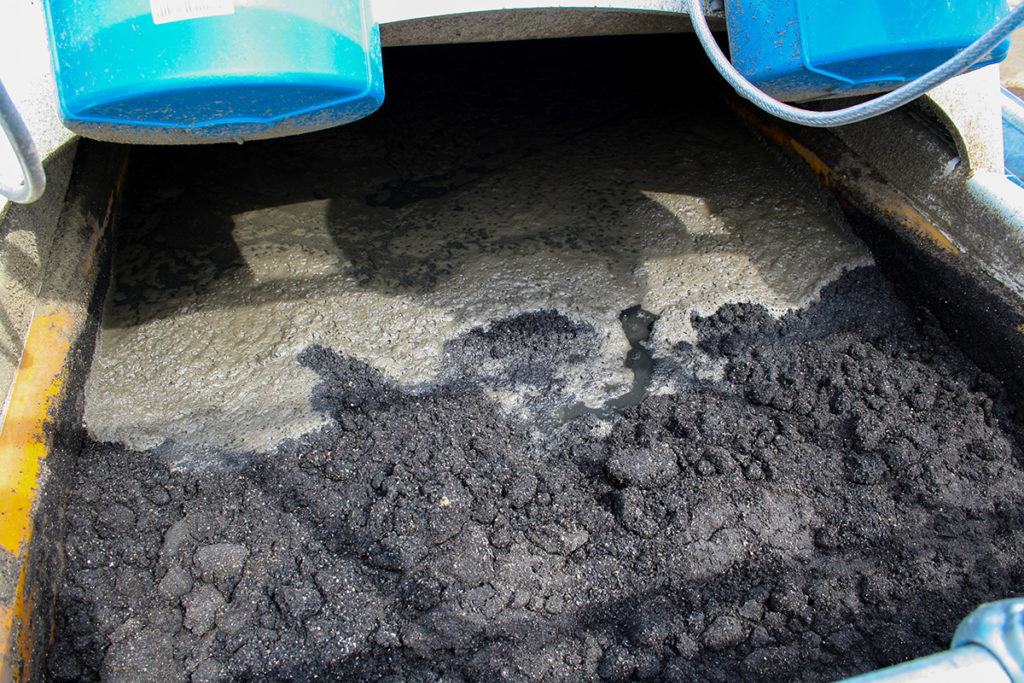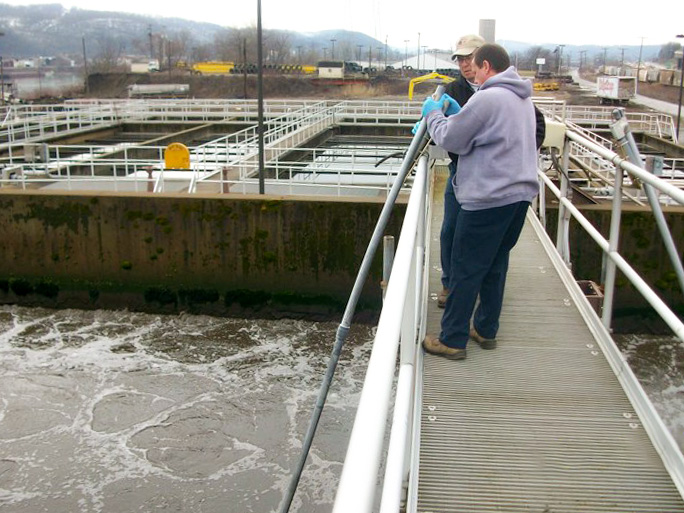Treatment Process
Eastern Ohio Regional Wastewater Authority (EORWA) currently has 8.3 miles of gravity sanitary sewer lines, 7.3 miles of force mains and 16 lift stations of varying sizes. The wastewater treatment plant is designed for an average daily flow of 5.00 mgd and 13.0 mgd peak flow.
Preliminary Treatment
Flow enters the wastewater plant from the lift stations through two force mains. An 18 inch force main flows from the south and a 20 inch force main flows from the north.

The wastewater passes through a Duperon automatic bar screen that removes solids greater that 1/2″ prior to entering the Smith & Loveless vortex pista grit trap. Next a Wemco hydrogritter pumps a constant flow to a Lakeside grit classifier and screw auger to dewater the grit which is trucked to a nearby landfill.

Primary Treatment
The flow proceeds to two 130′ x 37′ x 9’ deep primary settling tanks with a design detention time of 2.6 hours. Primary sludge and scum is pumped to the Egg Shaped Anaerobic Digester (ESD) by two Dorr-Oliver diaphragm type pumps. On average 50% of the Total Suspended Solids (TSS) and 30% of the Biological Oxygen Demand (BOD) is removed from the wastewater in the primary settling tanks.
Secondary Treatment
Flow from the primary settling tanks is routed to two 19’ long x 6’ diameter Archimedes screw pumps which lift the wastewater to the aeration basins.
The aeration basins consist of four tanks that are 35’ x 35’ x 14’ deep. The first two tanks are equipped with course bubble diffusers and the second two tanks are equipped with fine bubble diffusers. Aeration is provided to the diffusers by three Spencer centrifugal blowers rate at 2750 cfm each and driven by 100 HP motors.

The wastewater in these aeration basins is called activated sludge. Bacteria in the activated sludge process break down the dissolved and colloidal organic solids. The activated sludge leaves the aeration basins and flows to the two 106’ x 60’ x 12’ deep final clarifiers with a design detention time of 4.5 hours.
Return activated sludge is removed from the final clarifiers by two Aurora 3500 centrifugal pumps driven by 20-HP motors and returned to the first two aeration basins to supply fresh, hungry “bugs” to the wastewater. The waste activated sludge is removed by two Aurora 200 gpm centrifugal pumps driven by 5-HP motors and pumped to a 35’ diameter x 15’ deep aerated holding tank.
The aerated waste activated sludge from the holding tank is pumped to a 1 meter Ashbrook Simon Gravity Belt Thickener (GBT) that removes water from activated sludge and is then pumped to the Egg Shaped Digester at about 7.5% solids.

Disinfection
The final clarifier effluent flows to the Trojan UV4000 ultra violet light disinfection system. The UV system is a flow paced unit that increases and decreases the ultra violet intensity with the fluctuation of the flow. There are two control banks with 5 modules of 5 bulbs for a total of 40 bulbs that are mounted horizontally in the flow channel that disinfect the wastewater prior to its discharge into the Ohio River.
Sludge Treatment
Sludge from the primary settling tanks and gravity belt thickener is pumped to the 450,000 gallon egg shaped anaerobic digester.

The sludge in the digester is maintained at a constant temperature of 98.5 degrees Fahrenheit for a minimum of 15 days to reduce the pathogens and volatile solids are reduced to control the vector attraction in the sludge. During the digestion phase of pathogen and volatile solids reduction methane gas is produced and stored on site for heating of buildings and digesters.
Excess methane is flared off into the atmosphere. After digestion the sludge is held in two 450,000 gallons storage tanks. Sludge is then pumped from the holding tanks to a 2.0 meter Roediger Belt press which removes water from sludge and produces a 25% cake solid.
This is then land applied to soils as a Class B biosolid. The biosolids are used as a soil conditioner for reclaimed and stripped soils.